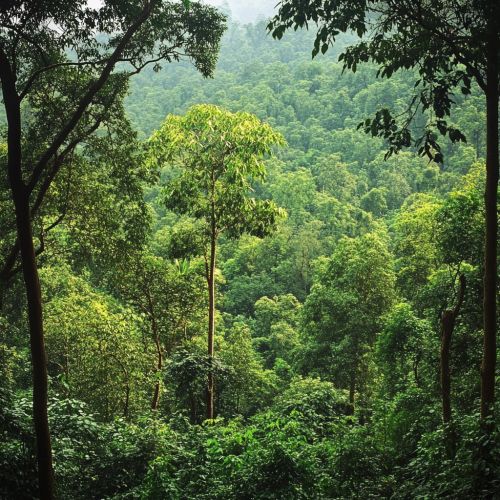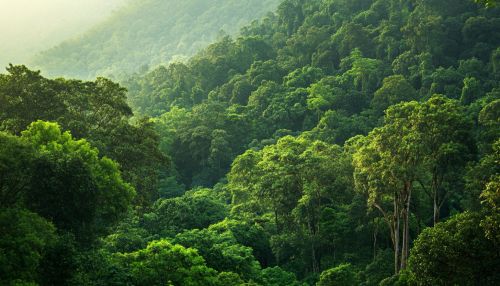Periyar Tiger Reserve
Introduction
The Periyar Tiger Reserve is a renowned protected area located in the Western Ghats of Kerala, India. It is one of the most significant tiger reserves in the country, known for its rich biodiversity and conservation efforts. The reserve is named after the Periyar River, which flows through it, providing a vital water source for the flora and fauna within the sanctuary.
Geography and Climate
The Periyar Tiger Reserve spans an area of approximately 925 square kilometers, encompassing a diverse range of habitats, including tropical evergreen forests, semi-evergreen forests, moist deciduous forests, and grasslands. The terrain is characterized by undulating hills, valleys, and water bodies, with altitudes ranging from 100 meters to 2,019 meters above sea level.
The climate of the reserve is predominantly tropical, with distinct wet and dry seasons. The monsoon season, from June to September, brings heavy rainfall, while the dry season, from December to March, is marked by lower humidity and cooler temperatures. The average annual rainfall is around 2,500 millimeters, contributing to the lush vegetation and thriving wildlife.
Flora
The Periyar Tiger Reserve is home to a wide variety of plant species, many of which are endemic to the Western Ghats. The vegetation is classified into different types based on altitude and moisture availability.
Tropical Evergreen Forests
These forests are found at higher altitudes and receive abundant rainfall. They are characterized by dense canopies and a rich diversity of tree species, including Dipterocarpus, Mesua ferrea, and Calophyllum. The undergrowth is thick with shrubs, climbers, and epiphytes.
Semi-Evergreen Forests
Located at mid-altitudes, these forests are a transition between evergreen and deciduous forests. They contain species such as Terminalia, Lagerstroemia, and Cullenia.
Moist Deciduous Forests
These forests are found at lower altitudes and are characterized by trees that shed their leaves during the dry season. Common species include Tectona grandis (teak), Dalbergia latifolia (rosewood), and Pterocarpus marsupium (Indian kino tree).
Grasslands
Grasslands in the reserve are primarily found in the high-altitude regions and are interspersed with patches of shola forests. These areas support a variety of grasses and herbaceous plants.


Fauna
The Periyar Tiger Reserve is renowned for its rich and diverse wildlife. It provides a habitat for several endangered and endemic species.
Mammals
The reserve is home to a significant population of Bengal tigers, which are the apex predators in the ecosystem. Other notable mammals include:
- Indian elephant (Elephas maximus indicus)
- Indian leopard (Panthera pardus fusca)
- Gaur (Bos gaurus)
- Sambar deer (Rusa unicolor)
- Wild boar (Sus scrofa)
- Nilgiri tahr (Nilgiritragus hylocrius)
Birds
The avifauna of the Periyar Tiger Reserve is equally impressive, with over 260 species of birds recorded. Some of the notable species include:
- Great hornbill (Buceros bicornis)
- Malabar grey hornbill (Ocyceros griseus)
- Nilgiri wood pigeon (Columba elphinstonii)
- White-bellied treepie (Dendrocitta leucogastra)
- Black baza (Aviceda leuphotes)
Reptiles and Amphibians
The reserve supports a diverse range of reptiles and amphibians, including several endemic species. Notable reptiles include the King cobra (Ophiophagus hannah), Malabar pit viper (Trimeresurus malabaricus), and the Indian rock python (Python molurus). Amphibians such as the Malabar gliding frog (Rhacophorus malabaricus) and the Beddome's leaping frog (Indirana beddomii) are also found here.
Conservation Efforts
The Periyar Tiger Reserve has been a focal point for various conservation initiatives aimed at protecting its unique biodiversity. These efforts are spearheaded by the Kerala Forest Department in collaboration with national and international organizations.
Project Tiger
Launched in 1973, Project Tiger is a major conservation program aimed at ensuring a viable population of tigers in their natural habitats. The Periyar Tiger Reserve was one of the initial reserves selected under this project. The program focuses on habitat management, anti-poaching measures, and community involvement.
Eco-Development Programs
Eco-development programs in the reserve aim to reduce the dependency of local communities on forest resources. These programs include the promotion of sustainable livelihoods, environmental education, and the establishment of eco-development committees (EDCs). The involvement of local communities is crucial for the success of conservation efforts.
Anti-Poaching Measures
The reserve employs a range of strategies to combat poaching, including the deployment of anti-poaching squads, the use of modern surveillance technology, and the establishment of intelligence networks. These measures have significantly reduced instances of poaching and illegal wildlife trade.
Tourism
The Periyar Tiger Reserve is a popular destination for eco-tourism, attracting visitors from around the world. The reserve offers a variety of activities that allow tourists to experience its natural beauty and wildlife.
Boat Safaris
One of the most popular activities in the reserve is the boat safari on the Periyar Lake. These safaris provide an opportunity to observe wildlife, including elephants, gaur, and various bird species, in their natural habitat.
Trekking and Nature Walks
The reserve offers several trekking and nature walk trails, ranging from short walks to more challenging treks. These trails are guided by trained naturalists who provide insights into the flora and fauna of the region.
Bamboo Rafting
Bamboo rafting is another unique activity offered in the reserve. It involves a combination of trekking and rafting on bamboo rafts, providing a different perspective of the forest and its wildlife.
Research and Monitoring
The Periyar Tiger Reserve is an important site for scientific research and monitoring. Various studies are conducted to understand the ecology, behavior, and population dynamics of the species within the reserve.
Wildlife Census
Regular wildlife censuses are conducted to monitor the population of key species, including tigers, elephants, and other large mammals. These censuses involve the use of camera traps, pugmark tracking, and direct sightings.
Habitat Studies
Research on habitat use and preferences of different species helps in the formulation of effective management strategies. Studies focus on aspects such as vegetation composition, prey availability, and human-wildlife interactions.
Climate Change Impact
The impact of climate change on the reserve's ecosystems is an area of ongoing research. Studies aim to understand how changing weather patterns affect the distribution and behavior of species, as well as the overall health of the forest.
Challenges
Despite the success of various conservation initiatives, the Periyar Tiger Reserve faces several challenges that threaten its biodiversity.
Human-Wildlife Conflict
Human-wildlife conflict is a significant issue, particularly in areas adjacent to the reserve. Crop raiding by elephants and livestock predation by tigers and leopards often lead to conflicts with local communities.
Invasive Species
The introduction of invasive species, such as Lantana camara and Eichhornia crassipes (water hyacinth), poses a threat to the native flora and fauna. These species compete with native plants and alter habitat conditions.
Climate Change
Climate change poses a long-term threat to the ecosystems of the Periyar Tiger Reserve. Changes in temperature and precipitation patterns can affect the distribution of species and the availability of water resources.
Management Strategies
Effective management strategies are crucial for addressing the challenges faced by the Periyar Tiger Reserve and ensuring the long-term conservation of its biodiversity.
Community Involvement
Involving local communities in conservation efforts is essential for the success of management strategies. Eco-development programs, environmental education, and the establishment of EDCs help build a sense of ownership and responsibility among the local population.
Habitat Restoration
Habitat restoration initiatives aim to improve the quality of degraded areas within the reserve. These initiatives include the removal of invasive species, reforestation, and the creation of waterholes to support wildlife during the dry season.
Monitoring and Research
Continuous monitoring and research are vital for informed decision-making. Data collected from wildlife censuses, habitat studies, and climate change research help in the formulation of adaptive management strategies.
Future Prospects
The future of the Periyar Tiger Reserve depends on the continued commitment to conservation and sustainable management. Efforts to address the challenges and threats faced by the reserve must be sustained and enhanced.
Sustainable Tourism
Promoting sustainable tourism practices can help generate revenue for conservation while minimizing the impact on the environment. Eco-friendly infrastructure, responsible wildlife viewing, and visitor education are key components of sustainable tourism.
Strengthening Partnerships
Collaboration with national and international organizations, research institutions, and local communities is essential for the success of conservation efforts. Strengthening these partnerships can enhance the effectiveness of management strategies and provide additional resources for conservation.
Climate Change Adaptation
Developing and implementing climate change adaptation strategies is crucial for the long-term resilience of the reserve's ecosystems. These strategies should focus on maintaining habitat connectivity, protecting water resources, and enhancing the adaptive capacity of species.
